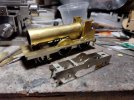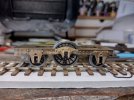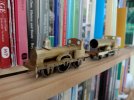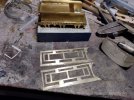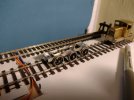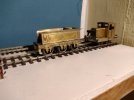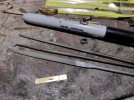2023.01 - GER 73 class #74
Herb Garden
Western Thunderer
Hello,
Greetings to you all....
With encouragement from @AJC @Rob R and @john lewsey I've started this post to tell the stories of the various bits of rolling stock I build. Or try to.....
This continues from a previous thread 'Greetings from Gosforth East' but for necessity of completeness I may end up repeating myself, apologies if I do.
The current major project at 'the sidings' is GER No 73 class. Which illustrates the type of thing I usually build... Victorian/Edwardian East Anglian stock....
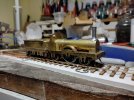
The locomotive is entirely scratch built and has taken me since may to get to what I think is about 70% complete.... You can do the maths yourselves....
As the class is an often ignored footnote in GER locomotive history allow me to give you a brief history of the real thing.
In the 1840s the East Anglian Railway and Eastern Union Railway both purchased a number of similar 5'6" drived 2-2-2 locos from Sharp bros of Manchester... These 'sharpies' (not to be confused with the later GER no 1 class) were for the 1840s about as close as you could get to an off the shelf catalogue item for that time. And many railways including the Manchester and Sheffield and London and Birmingham had them to a total I have been told of approx 600 of these being built. The GER in 1862 absorbing 21of these... As built illustration....
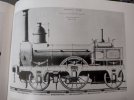
By the late 1860s this fleet, which was a large class for the time (there were more of these on the GER than J65s!), Was getting long in the tooth and Robert Sinclair instigated a rebuilding program which was continued by Sam Johnson when he took over at Stratford. This rebuilding covered new boilers and cab weatherboards but didn't alter much more. However the last 8 locos were treated rather differently.
The next 6 that were withdrawn were combined into 3 2-4-0 outside frame locos using the cylinders, motion sets and tender from one loco and the driving wheels from both. This became the no 109 class and more on these anon.... I've cut the main frames for a 109 but nothing else as yet
The last two, which based on withdrawal dates were two of no's 110, 114, 115.. (we aren't sure which two but I can share more thoughts and research on this another time) were kept at 2-2-2s but we're rebuilt with brand new cabs and new boilers and even given new numbers and listed as new builds.... But we know that they were just a new boiler on an old chassis. No's 73 & 74 were outshopped in 1870.
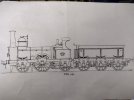
Sadly for unknown reasons they didn't last long 73 going in 1877 and 74 going a couple of years later. I find this rather sad and an uncharacteristic of the GER whom in early days were veritable horders where old locos were concerned.
To rectify this my model of 73 will bend the space time continuum and carry similar features and fittings to other GER locos rebuilt at the end of the 1870s. Stovepipe chimney. Unflared smoke box, a more modest done and sv arrangement, Westinghouse and possible it might even get the early ultramarine blue livery.... Who knows....

Sorry that's a lot of intro for a small engine .... I will promise to put some more photos up of how it went together... And some of the mistakes made....
Herbie
Greetings to you all....
With encouragement from @AJC @Rob R and @john lewsey I've started this post to tell the stories of the various bits of rolling stock I build. Or try to.....
This continues from a previous thread 'Greetings from Gosforth East' but for necessity of completeness I may end up repeating myself, apologies if I do.
The current major project at 'the sidings' is GER No 73 class. Which illustrates the type of thing I usually build... Victorian/Edwardian East Anglian stock....

The locomotive is entirely scratch built and has taken me since may to get to what I think is about 70% complete.... You can do the maths yourselves....
As the class is an often ignored footnote in GER locomotive history allow me to give you a brief history of the real thing.
In the 1840s the East Anglian Railway and Eastern Union Railway both purchased a number of similar 5'6" drived 2-2-2 locos from Sharp bros of Manchester... These 'sharpies' (not to be confused with the later GER no 1 class) were for the 1840s about as close as you could get to an off the shelf catalogue item for that time. And many railways including the Manchester and Sheffield and London and Birmingham had them to a total I have been told of approx 600 of these being built. The GER in 1862 absorbing 21of these... As built illustration....

By the late 1860s this fleet, which was a large class for the time (there were more of these on the GER than J65s!), Was getting long in the tooth and Robert Sinclair instigated a rebuilding program which was continued by Sam Johnson when he took over at Stratford. This rebuilding covered new boilers and cab weatherboards but didn't alter much more. However the last 8 locos were treated rather differently.
The next 6 that were withdrawn were combined into 3 2-4-0 outside frame locos using the cylinders, motion sets and tender from one loco and the driving wheels from both. This became the no 109 class and more on these anon.... I've cut the main frames for a 109 but nothing else as yet
The last two, which based on withdrawal dates were two of no's 110, 114, 115.. (we aren't sure which two but I can share more thoughts and research on this another time) were kept at 2-2-2s but we're rebuilt with brand new cabs and new boilers and even given new numbers and listed as new builds.... But we know that they were just a new boiler on an old chassis. No's 73 & 74 were outshopped in 1870.

Sadly for unknown reasons they didn't last long 73 going in 1877 and 74 going a couple of years later. I find this rather sad and an uncharacteristic of the GER whom in early days were veritable horders where old locos were concerned.
To rectify this my model of 73 will bend the space time continuum and carry similar features and fittings to other GER locos rebuilt at the end of the 1870s. Stovepipe chimney. Unflared smoke box, a more modest done and sv arrangement, Westinghouse and possible it might even get the early ultramarine blue livery.... Who knows....

Sorry that's a lot of intro for a small engine .... I will promise to put some more photos up of how it went together... And some of the mistakes made....
Herbie
Last edited:


